Fantasia 2018, Day 11, Part 1: Fireworks and Lôi Báo
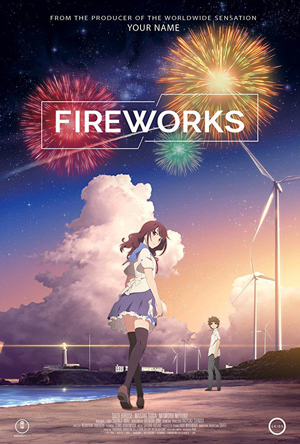 I knew Sunday, July 22, was going to be a long day for me at Fantasia. That was a good thing: it meant I’d be watching a lot of movies. At a certain point, I knew I’d have to make a choice about which ones I’d be seeing. But at least the first two were set in my mind, both playing at the Hall Theatre. The first was Fireworks, an anime tween love story with a time-twisting aspect. The second was Lôi Báo, a Vietnamese super-hero movie.
I knew Sunday, July 22, was going to be a long day for me at Fantasia. That was a good thing: it meant I’d be watching a lot of movies. At a certain point, I knew I’d have to make a choice about which ones I’d be seeing. But at least the first two were set in my mind, both playing at the Hall Theatre. The first was Fireworks, an anime tween love story with a time-twisting aspect. The second was Lôi Báo, a Vietnamese super-hero movie.
Fireworks, or to give its full title, Fireworks, Should We See It from the Side or The Bottom? (Uchiage hanabi, shita kara miru ka? Yoko kara miru ka?, 打ち上げ花火、下から見るか?横から見るか?), was directed by Akiyuki Shinbo and Nobuyuki Takeuchi from a script by Hitoshi Ohne, and is based on a 1995 film of the same name written and directed by Shunji Iwai. It follows youngsters Norimichi (Masaki Suda, Gintama, Death Note: Light Up the New World, Assassination Classroom, Princess Jellyfish) and Nazuna (voiced by Suzu Hirose, the lead in Laplace’s Witch), schoolmates in a seaside Japanese town. One morning, the morning her mother plans to leave town with her, Nazuna finds a strange glass sphere. Norimichi has a crush on her and had been planning to ask her to watch a large fireworks display with him that evening, but things go awry and Nazuna chooses to go with Norimichi’s friend Yusuke (Mamoru Miyano) instead. Only, at about the halfway point of the film, everything changes: a secret property of the strange glass sphere emerges, and the day begins again with Norimichi given another chance to get together with Nazuna.
Stylistically, this is a very realistic-looking movie with a few departures into fantasy sequences. Lighting effects, as you might imagine given the title, are extensive and often beautiful. This is a bright film in general with highly saturated colours. The design and direction works with the animation to create a strong sense of place — the village feels like a real hillside village, laid out in three dimensions. You get the idea swiftly where everything is relative to everything else, and a few shots of the town as a whole help. The character animation is mostly effective; I didn’t notice especially subtle touches to Norimichi or the boys he hung around with, but their body language does do a decent job of establishing who they are. The coltish Nazuna’s a little more distinctive, with a dream sequence near the end giving a sense of her character through movement (as well as through exposition and imagery).
Narratively, the movie uses a setup not unlike Groundhog Day, with a protagonist who gets to live through a day and change things as needed. Fireworks presents a useful twist, though, in that the world around Norimichi gets a little smaller and a little more deformed each time he does this. You can see that the final version of the world won’t be stable. But then you can also see that there are limits to how much the young people in this film can affect the world in any case; their ability to connect with each other is limited by circumstance, and in a way that’s what the movie’s about. If one of the characteristics of a fireworks display is its intensity, another is its transience: however beautiful, fireworks fade.
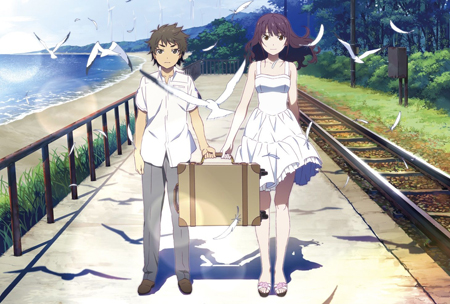 This is essentially a romance film with science-fictional aspects, and as such the characters make or break the film. To me, Fireworks is a mixed bag, though. Norimichi’s too average to really stand out. It’s not clear at all why Nazuna’s attracted to him over Yusuke. Nazuma herself is more interesting; there’s a bit of manic-pixieness to her, but I felt the movie did a reasonably good job of giving her a family context and showing the motivations of her behaviour. I found myself rather more interested in her acting out and rebelling against her mother than in Norimichi’s internal debates about whether to hang around with his buddies or with her.
This is essentially a romance film with science-fictional aspects, and as such the characters make or break the film. To me, Fireworks is a mixed bag, though. Norimichi’s too average to really stand out. It’s not clear at all why Nazuna’s attracted to him over Yusuke. Nazuma herself is more interesting; there’s a bit of manic-pixieness to her, but I felt the movie did a reasonably good job of giving her a family context and showing the motivations of her behaviour. I found myself rather more interested in her acting out and rebelling against her mother than in Norimichi’s internal debates about whether to hang around with his buddies or with her.
More generally, I found myself unsure of the film’s depiction of late childhood (or early adolescence, if you prefer). It felt romanticised to me, although it may just be an accurate presentation of an experience very different from my own recollections of that age. But the social dynamic’s limited. The boys have a fixed friend group that doesn’t seem to have any internal stresses. Nazuna’s more of an outcast, but there’s minimal sense of other girls in the school. The main romantic fixation for most of the boys is one of their teachers, and I should note that while that’s fine to a point, there’s a level of behaviour that occasionally feels like sexual harassment — meaning primarily that the behaviour makes the characters unsympathetic, but incidentally also makes it difficult to see how the classroom, their social world, functions coherently.
All these things observed, I will also say that the movie does get one thing about childhood: the feel of rushing toward a future with no real idea where you’re going. The characters here are in a constant state of motion, sometimes self-directed and sometimes pulled along by fate. What that fate holds is unclear, but there’s an interesting sense of realism in the way the kids think about their future lives. Nazuna has dreams about becoming a star of one kind or another, but Norimichi’s more skeptical, even more hesitant about taking risks. So to an extent there’s an interesting sense in which the movie uses fireworks as an image in another way, encouraging Nazuna’s hope of flaring brightly if perhaps briefly.
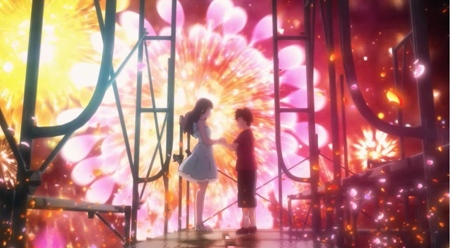 Still, I feel that the movie’s central device is an odd one to use with preteen or early-teen characters. They’re at a stage of life where the future’s largely ahead of them. If they’ve made mistakes in the past, they have time before them to undo those mistakes. Norimichi’s pursuit of a day with Nazumi feels weirdly unimportant. This is, of course, coming from an older viewer. But in this, as in other aspects of the movie, there seems to me to be a certain lack of gravity. That’s a potential problem with the Groundhog Day structure, the sense that one can always return to a save point. The increasing implication that the world’s getting warped by Norimichi’s rebooting helps, but the actual relationship that’s the point of the film did not to me feel well-served by the central gimmick.
Still, I feel that the movie’s central device is an odd one to use with preteen or early-teen characters. They’re at a stage of life where the future’s largely ahead of them. If they’ve made mistakes in the past, they have time before them to undo those mistakes. Norimichi’s pursuit of a day with Nazumi feels weirdly unimportant. This is, of course, coming from an older viewer. But in this, as in other aspects of the movie, there seems to me to be a certain lack of gravity. That’s a potential problem with the Groundhog Day structure, the sense that one can always return to a save point. The increasing implication that the world’s getting warped by Norimichi’s rebooting helps, but the actual relationship that’s the point of the film did not to me feel well-served by the central gimmick.
Fireworks strikes me as a well-crafted film with some thoughtful ideas, but one that’s a bit wide of the mark. The characters aren’t quite gripping enough, and their relationship never really feels especially convincing. The movie looks spectacular, but the story’s less true-to-life than the art. The fantastic idea at the story’s core doesn’t feel like it’s emotionally central. There are some fine pieces to this film, but I didn’t feel they were assembled into a terribly satisfying whole.
Next would come Lôi Báo. It was preceded by a short, though, a six-minute story called “Hooligans.” It follows a team in a kind of fight club, where small gangs meet to beat the hell out of each other on a soccer pitch. One of the gangs has recruited a new member who’s unbeatable in a fight — but turns out to have another problem. Written and directed by Adam-Gabriel Belley-Côté, it’s brief and witty enough, with enough grace notes to keep it from feeling like a one-gag film. The performers (the festival web site lists François-Xavier Dufour, Vincent Fafard, and Nicolas Paquin) are all energetic and sell the central idea effectively. It was a nice little piece.
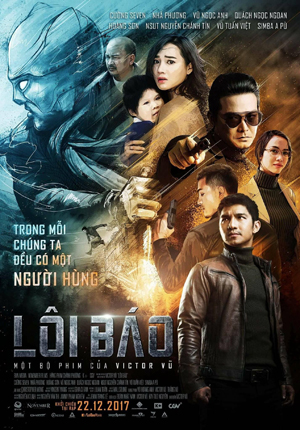 Then Lôi Báo (which I believe translates as In The Storm). It’s directed by Victor Vu, who also worked on the script along with Nam Doan Nhat and Kay-Tilo Nguyen. Tam (Cuong Seven) is a comics artist who wants to create Vietnam’s first home-grown superhero graphic novel. Unfortunately, he’s diagnosed with terminal cancer. Fortunately, a friend of his is an elderly professor (Hoang Son) with a history of medical experimentation, which becomes relevant when they see a man shot dead and the professor reveals he can save Tam’s life — by transplanting his head onto the dead man’s body. An unexpected side-effect of the process gives Tam unexpected strength and speed, as well as an assortment of instincts, training, and memories from the dead man, a killer named Nghia. But it doesn’t seem to help him with his drawing, while the people after the dead man are now interested in Tam — and his son and wife Linh (Tran Thi Nha Phuong).
Then Lôi Báo (which I believe translates as In The Storm). It’s directed by Victor Vu, who also worked on the script along with Nam Doan Nhat and Kay-Tilo Nguyen. Tam (Cuong Seven) is a comics artist who wants to create Vietnam’s first home-grown superhero graphic novel. Unfortunately, he’s diagnosed with terminal cancer. Fortunately, a friend of his is an elderly professor (Hoang Son) with a history of medical experimentation, which becomes relevant when they see a man shot dead and the professor reveals he can save Tam’s life — by transplanting his head onto the dead man’s body. An unexpected side-effect of the process gives Tam unexpected strength and speed, as well as an assortment of instincts, training, and memories from the dead man, a killer named Nghia. But it doesn’t seem to help him with his drawing, while the people after the dead man are now interested in Tam — and his son and wife Linh (Tran Thi Nha Phuong).
The plot here is engagingly complex, more than it at first appears. Tam explores Nghia’s life while his current one’s threatened by the way his personality changes; add in an old flame of Nghia’s, and there’s a good variety of plot threads even before we get to the forces of the underworld. The movie juggles these things dextrously, although some will find it overly neat. Personally I liked the melodramatic aspect that emerged as the movie went along; I thought the tone was perfectly in keeping with the genre. One way or another, all the intrigues and twists end up with a satisfying climax.
The action scenes were effective, aside from one superhuman hand-to-hand move that (to my eye) didn’t come off especially well. But apparently Cuong Seven was a dancer before becoming an acting, and that coordination serves him well here. In fact, I wish there’d been more action scenes — there’s a large stretch in the middle of the film where Tam doesn’t get to do any fighting. He does take part in the old standby of non-violent super-hero scenes, saving people in a tall building from a fire; but there’s something of a lack of tension in this part of the film.
An exchange between Tam and his friend Professor Ma does try to head this off, establishing that some super-hero stories need to establish character rather than focus on action. It’s a clever use of a lampshade, but to my mind misses the point of the genre: in a super-hero story fight scenes should establish and advance character, as well as plot and theme. They’re a fundamental structural unit of the story, and there’s few enough of them in Lôi Báo that for extended stretches it feels more like a standard action thriller than the super-hero story it seems to want to be. Put another way: it’s too much a super-hero story to be anything else, but too little a super-hero story to be fully satisfying as such.
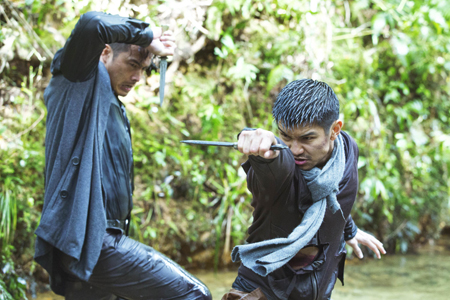 On the whole the story’s caught between big-concept super-hero structures and a more mimetic approach. The action’s kept admirably small-scale, and Tam’s family life is convincing though it’s depiction isn’t particularly sophisticated — writing is clear if on-the-nose, motivations are spelled out, and so forth. This does mean that the characters say what’s on their mind in a way that makes sense for a happily-married couple. The thing is, if there’s a lack of action, then Tam’s character and relationships become central in a way the film isn’t quite ready to handle. And I’m not sure it makes sense to assume they should: this is still a film in which the character’s buddy happens to have a lab handy that can do a full head transplant.
On the whole the story’s caught between big-concept super-hero structures and a more mimetic approach. The action’s kept admirably small-scale, and Tam’s family life is convincing though it’s depiction isn’t particularly sophisticated — writing is clear if on-the-nose, motivations are spelled out, and so forth. This does mean that the characters say what’s on their mind in a way that makes sense for a happily-married couple. The thing is, if there’s a lack of action, then Tam’s character and relationships become central in a way the film isn’t quite ready to handle. And I’m not sure it makes sense to assume they should: this is still a film in which the character’s buddy happens to have a lab handy that can do a full head transplant.
The pacing’s deliberate, not so much in the rhythm of edits, but in terms of the construction of scenes and the doling out of information. Tam’s ‘origin’ is shown in detail, so we understand at every point what’s happening to him. As his power begins to affect him, the movie’s careful to explain that as well. It’s all used to establish maximum drama, but at the same time the movie makes full use of super-hero clichés. It’s straight-faced but I think also self-aware, an interesting mix.
I would say that Lôi Báo reminds me of a super-hero movie from the days before the Marvel Cinematic Universe — something like Darkman, say. It’s a film that seems to be getting its audience used to the concept of its hero, a film careful not to get too far out in front of what its viewers will understand and accept. That doesn’t mean it’s a bad movie, but at times it feels elementary. I think Vu understands super-heroes at a reasonably deep level; the way Tam’s powers come at a cost, and bring a certain kind of curse with them, feels very much like a classic super-hero set-up. Still, he’s made a relatively conservative super-hero film (artistically speaking), if one that’s very watchable.
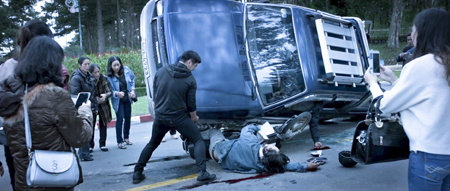 Visually, the movie’s strong, with a good sense of scope. Tam’s city of Da Lat comes across as a consistent place, which is no small thing for a super-hero story. Most solo heroes who aren’t cosmic need an urban background that fits them, and Da Lat serves well here — not too large, very modern, but still possessing distinctive cityscapes. The colours are surprisingly subdued, perhaps a nod at the low-powered nature of this hero. The acting’s solid but not especially notable.
Visually, the movie’s strong, with a good sense of scope. Tam’s city of Da Lat comes across as a consistent place, which is no small thing for a super-hero story. Most solo heroes who aren’t cosmic need an urban background that fits them, and Da Lat serves well here — not too large, very modern, but still possessing distinctive cityscapes. The colours are surprisingly subdued, perhaps a nod at the low-powered nature of this hero. The acting’s solid but not especially notable.
Add it all up, and Lôi Báo’s inessential but not uninteresting. It’s not the most compelling super-hero movie I’ve ever seen, but it’s far from the worst. It’s the sort of thing I can imagine coming to seem, in the fullness of time, as a step toward some later and better work, whether in the director’s career or some yet-to-be-developed Vietnamese super-hero canon. If you like the genre, it’s worth a look.
Find the rest of my Fantasia coverage here!
Matthew David Surridge is the author of “The Word of Azrael,” from Black Gate 14. You can buy his first collection of essays, looking at some fantasy novels of the twenty-first century, here. His second collection, looking at some fantasy from the twentieth century, is here. You can find him on Facebook, or follow his Twitter account, Fell_Gard.